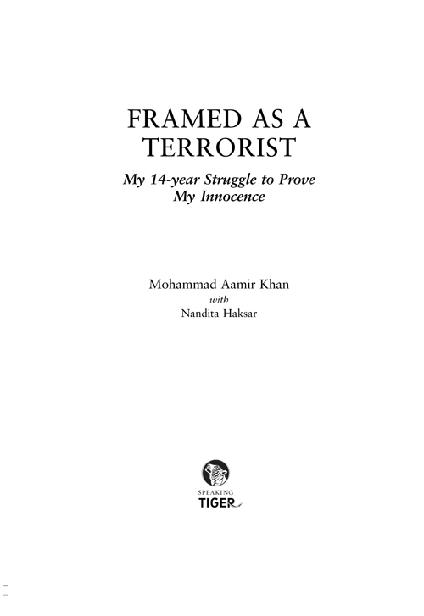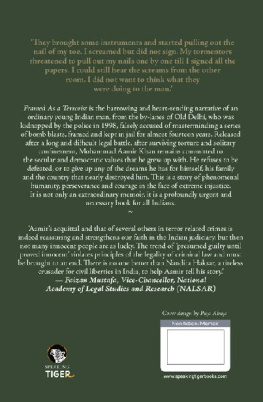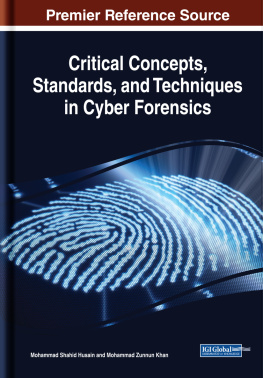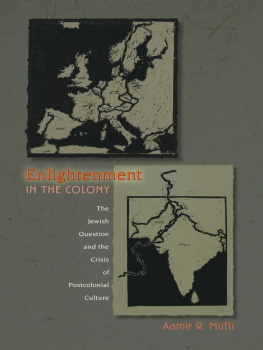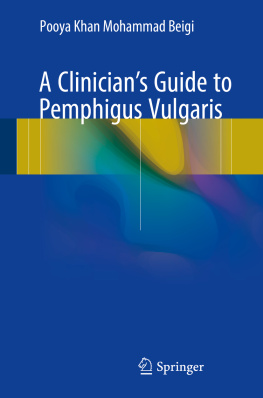Mohammad Aamir Khan was born in 1977. In 1998 he was kidnapped, tortured and framed in eighteen bomb blast cases. It took him fourteen years to prove his innocence and now he is a free man. When he finally came out of jail he was stepping out into a drastically changed worldhis father was dead and his mother paralyzed. He had no job and no security. Despite the daily challenges to survive and support his family he has involved himself in the struggles of people fighting discrimination and oppression. Aamir has worked for NGOs involved in the area of democratic rights and secularism. His work in Shabnam Hashmis Anhad took him to various corners of India and he has become a part of the community of activists fighting against discrimination in various spheresreligious minorities, prisoners rights, the oppression of women and the rights of the LGBT community. Aamir has been widely interviewed by national and international media. He has used the opportunity to speak eloquently on issues relating to human rights and democracy and has emerged as a powerful voice of democratic India. Aamir is married to Alia, who waited fourteen years for him. They live in Old Delhi with their daughter.
Nandita Haksar is a human rights lawyer, campaigner, teacher and writer.
To the memory of Abbu Jaan and Ammi Jaan
and special thanks to sweet Alia
CONTENTS
THE CONTEXT
This is a story about Aamir, an ordinary young man born in a Muslim family living in the by-lanes of Old Delhi; a youth who dreamt of a conventional future for himself: marriage, family, a nice home and a decent job.
Aamirs dreams were cut short when he was kidnapped by the police and found himself accused of being a terrorist, planting bombs and being in league with dreaded Pakistan-based militants. And the bizarre events led to his imprisonment which lasted nearly fourteen years.
Aamirs story is exceptional because despite all he and his family suffered, he refused to give up the values and principles he had been brought up with. He sees his secular and democratic values as a bequest left to him by his father, a committed member of the Congress Party, even though the Congress Party itself had betrayed those values.
Aamir has been a witness, even while he was behind bars, to the rise of Hindu fascism and Muslim fundamentalism; he has seen the invisible walls rise up between the Hindu and Muslim communities. Despite this Aamir continues to build bridges between communities. At least a part of the reason for Aamirs belief in the values of secularism and democracy is found in the history of Old Delhi, where he was born and where he grew up and lives even now.
Growing Up in Delhi-6
Old Delhi was once known as Shahjehanabad; the city built by the Mughal Emperor Shahjehan in 1648. Shahjehanabad was a beautiful city with leafy trees and gardens and the beautiful fortress-palace called Qila-Mubarak which faced the stunning mosque, the Jama Masjid.
Even as late as the1780s there were sixty bazars in the city and plenty of food. Delhi survived the Afghan and Maratha invasions and then the British took over the city from the Marathas in 1803. Despite all these invasions Delhi was proud of its unique and vibrant culture which united Hindus and Muslims in a camaraderie rarely witnessed in other parts of the country. The number of Hindus and Muslims were consistently equal and both could be seen at the court, the gatherings in Chandni Chowk, around the dastangos, at weddings and the annual Gul-faroshan, the festival of flower-sellers celebrated by both Hindus and Muslims, which has survived till today and is known as Phool Walon ki Sair .
The love of Urdu language, courtly etiquette, the weekly musharas, the patangbazi and the kabutarbaziall were a part of a shared culture and civilization.
This unique culture was given a deathly blow in the aftermath of the revolt of 1857 when the British crushed Indias first war of independence. The Red Fort and the Jama Masjid were occupied by the British troops; Muslims were banished from the city as also the Hindus who took part in the uprising.
Mirza Ghalib, Delhis most famous poet, a witness to the decay and destruction of his beloved city lamented: Allah Allah Dilli Na Rahi, Chavni Hai, Na qila, na shaher, na bazar, na nahar; Qissa mukhtasar shahar Sahra ho gaya (Oh Allah! Delhi is no more; it is now a cantonment, no fort, no city, no bazars, no canal; in a word, the city is a desert).
Shahjehanabad had become Delhi and after 1912 it was called Old Delhi in contrast to the New Delhi which was being built by the British as their new Imperial capital. Sometimes Old Delhi is called the Walled City even now; an allusion to the time when the city was protected by thirteen gates. Today the Kashmere Gate stands as a silent reminder of the times gone by.
The British abolished the old chowkidari system and replaced it with a new police force which was heartily disliked by all, even the Europeans and loyalists. They employed Gujjars and Jats and promoted stereotypical images of Hindus and Muslims as two separate and antagonistic communities. A legacy which plagues us till this day.
Then came the violence and agonies of the Partition. British India was partitioned into two sovereign states, India and Pakistan. The Partition was perhaps the most cruel and bloody in history. Some two million Hindus, Muslims and Sikhs were murdered in the violence and seventeen million people were forcibly transferred between the two countries.
By the time Aamir was born the transformation of Old Delhi into Delhi-6 was complete. It began with the influx of the Punjabi refugees and later migrant workers from all over India. From a beautiful city known for its gardens and canals, its bazars and its culture, Old Delhi is now a commercial slum known by its pin code: 110006 or, simply, as Delhi-6.
Old Delhi or Delhi-6 is the smallest district in terms of size with an area of 25 sq. km, and a population of 5.7 lakh according to the 2011 census; a population density of 23,149 persons per sq. km.
90 per cent of Delhi-6 is a slum with noxious and obnoxious factories housed in 616 katras, 260 kuchas, 193 kachchi bastis and 87 pakki bastis and 274 mixed ones with no proper ventilation, drainage or sewer lines besides being messed up with fatally dangerous electricity wires hanging overhead that cause recurrent fires.
The Muslims of Old Delhi find themselves ghettoized within narrow by-lanes. Many have been impoverished since the time of the Partition and cannot afford education for their children or medical treatment for the elderly; they live in constant fear and uncertainty, victims of state and communal violence and now more recently of the so-called war against terror.
Aamir was born in Delhi-6. As he grew up the by-lanes of his neighbourhood were tense; the Muslims felt increasingly under siege. There was a growing Muslim resentment and anger against an attack on their religion; whether it was the Shah Bano case in 1985; the Rushdie affair in the 1990s and the demolition of the Babri Masjid in December of 1992. Aamirs father watched the rise of Hindu fascism and, as a reaction, the growth of radical Islam but he kept his son safe from physical violence and any influence of communal ideologies. Aamir grew up knowing that there were dangers lurking outside but he had no idea how terrifying they could be. His was a happy childhood.
An Amateur Spy
In many ways Aamir is a victim of Partition. His own family was partitioned when his older sister married a Pakistani. Thus for the families who were divided by international boundaries the Partition is not something which happened in the past; it continues to impact their lives on a daily basis.
